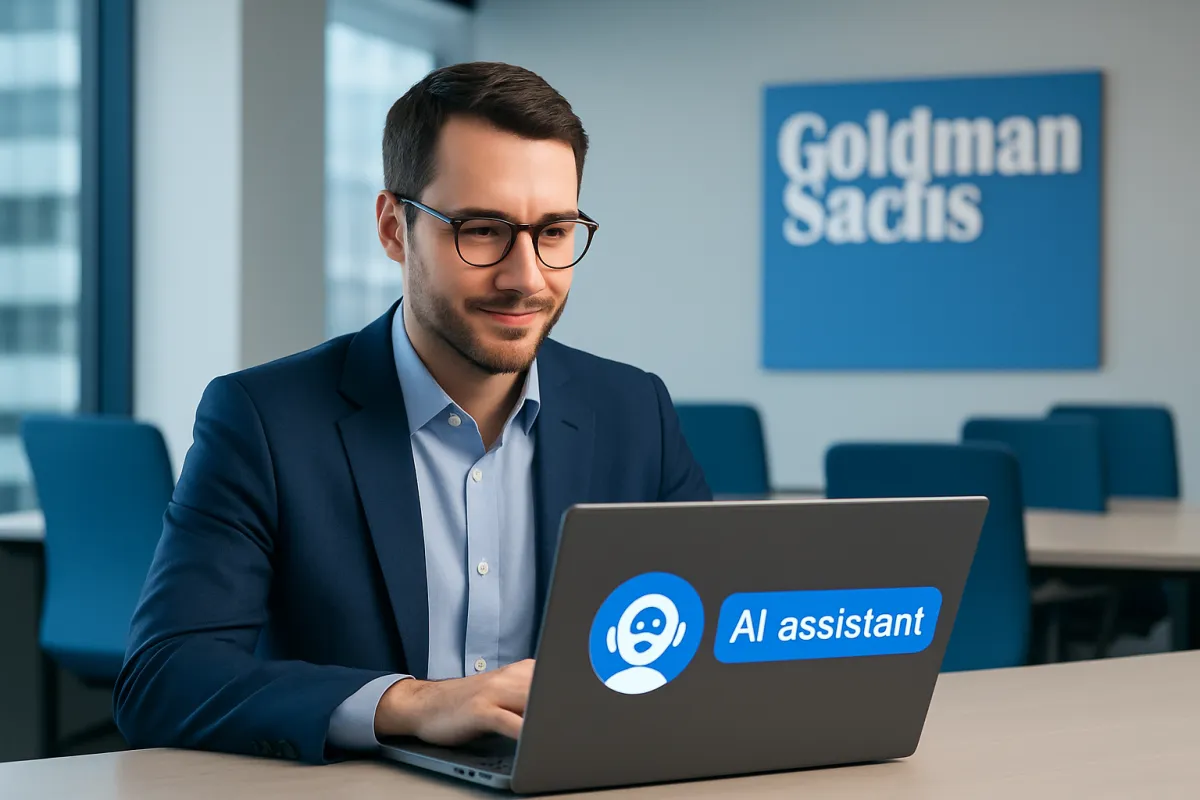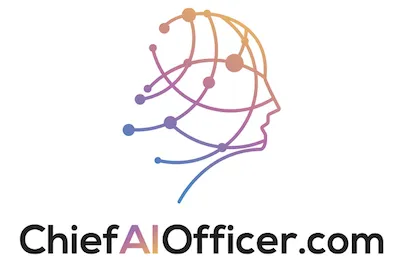
Goldman Sachs Just Put AI on Every Employee's Desk While Your Company Is Still "Evaluating" AI
Goldman Sachs Just Put AI on Every Employee's Desk While Your Company Is Still "Evaluating" AI
Goldman Sachs just completed one of the most aggressive AI deployments in corporate history. They didn't run another pilot program. They didn't form another committee. They didn't wait for more research. They put AI assistants on every single desk across their entire 46,000-person global workforce.
While most executives are still scheduling meetings about AI strategy, Goldman Sachs is already measuring productivity gains of up to 20% from AI implementation. While competitors debate AI potential, Goldman is documenting AI results across investment banking, wealth management, research, and asset management operations.
This isn't just a financial services story. This is a competitive strategy case study that reveals exactly how market leaders approach AI transformation while their competitors get stuck in analysis paralysis.
The Scale Decision That Changes Everything
After a pilot phase involving 10,000 employees, Goldman Sachs launched their AI assistant to all 46,000+ staff worldwide. This progression from pilot to enterprise deployment happened faster than most companies complete their AI vendor selection process.
The scale decision reveals strategic thinking that separates market leaders from market followers. Instead of extending pilot programs indefinitely, Goldman committed to enterprise transformation based on proven results. Instead of waiting for perfect technology, they implemented effective technology immediately.
Most executive teams treat AI deployment as risk management rather than competitive strategy. Goldman treated AI deployment as competitive necessity that required immediate enterprise-wide implementation to maintain market leadership.
The Multi-Model Strategy That Proves Sophistication
Goldman's AI assistant leverages multiple large language models including OpenAI's GPT-4o, Google's Gemini, Anthropic's Claude, and select open-source models, all securely firewalled within Goldman's infrastructure. This multi-model approach demonstrates AI strategy sophistication that most companies haven't considered.
The multi-model strategy provides competitive advantages through capability diversification rather than vendor dependence. Different AI models excel at different tasks, and Goldman's approach optimizes performance across diverse business functions rather than accepting limitations of single AI platforms.
Executive teams that approach AI through single-vendor strategies limit their competitive potential compared to organizations that leverage best-of-breed AI capabilities for specific business requirements.
The Task Automation Portfolio
Goldman's AI assistant automates document summarization, content drafting, data analysis, coding assistance, translation, database navigation, and client communication management. This comprehensive automation portfolio reveals how enterprise AI creates value across every aspect of knowledge work.
The automation portfolio demonstrates how successful AI implementation targets entire workflow transformation rather than individual task improvement. Goldman isn't just making existing processes faster—they're enabling entirely new operational capabilities that competitors can't match.
Organizations that approach AI through narrow use cases miss opportunities for comprehensive competitive advantage that enterprise-wide automation portfolios provide.
The Role-Specific Customization Advantage
Features are tailored for different job functions including developers, investment bankers, research analysts, and asset and wealth management professionals. This customization approach ensures AI relevance across diverse business functions rather than generic tool deployment.
Role-specific customization demonstrates how successful AI implementation addresses actual work requirements rather than theoretical use cases. Goldman's approach provides immediate value to every employee rather than limiting AI benefits to specific departments or functions.
Executive teams that deploy generic AI tools across their organizations achieve lower adoption and impact than organizations that customize AI capabilities for specific role requirements and business contexts.
The Productivity Transformation Results
Early reports indicate measurable efficiency gains with some teams citing up to 20% improvements in productivity. These documented results represent AI impact that flows directly to competitive advantage and financial performance.
Twenty percent productivity improvement across 46,000 employees represents competitive advantages that traditional operational improvements cannot match. When enterprise AI implementation delivers documented productivity gains, market position advantages compound over time.
Organizations that achieve similar productivity improvements through AI implementation will dominate competitors who continue operating with traditional productivity constraints.
The Strategic Leadership Communication
Goldman's Chief Information Officer Marco Argenti emphasizes that the AI assistant augments human work rather than replacing jobs, focusing on reducing manual tasks so employees can concentrate on strategic and client-facing responsibilities.
The leadership communication strategy reveals how successful AI implementation requires clear workforce messaging that builds adoption rather than resistance. Goldman's augmentation approach encourages employee AI collaboration rather than creating AI adoption barriers.
Executive teams that approach AI communication through job security reassurance rather than capability enhancement miss opportunities to accelerate workforce AI adoption and competitive advantage capture.
The Industry Context That Demands Response
Goldman Sachs joins Citigroup, Morgan Stanley, and Bank of America in launching comprehensive internal AI tools for policy searches, document summarization, client interactions, and transaction management. This industry-wide AI adoption creates new competitive baseline requirements.
The industry context reveals how AI transformation affects entire market sectors rather than individual companies. When major competitors implement enterprise AI capabilities, remaining competitive requires equivalent or superior AI implementation.
Executive teams in every industry face similar competitive dynamics as AI leaders establish new performance standards that traditional approaches cannot match.
The Workforce Impact Strategy
Despite official statements downplaying immediate layoffs, industry reports suggest that up to 200,000 Wall Street jobs could be at risk within five years as AI adoption accelerates, particularly in back- and middle-office roles.
The workforce impact strategy demonstrates how AI transformation creates both enhancement opportunities and displacement risks that require proactive management. Goldman's upskilling and training investments prepare their workforce for AI collaboration rather than AI replacement.
Organizations that invest in workforce AI adaptation will maintain employee engagement and capability advantages over organizations that ignore AI workforce transformation requirements.
The Security Framework Implementation
Goldman's AI assistant operates behind their firewall with strict controls preventing sensitive financial data from leaking outside their secure environment. This security framework enables AI adoption while maintaining regulatory compliance and competitive information protection.
The security implementation demonstrates how enterprise AI requires sophisticated data protection that consumer AI tools cannot provide. Organizations that solve AI security challenges through enterprise infrastructure gain competitive advantages while protecting sensitive information.
Executive teams that delay AI implementation due to security concerns should study Goldman's approach to secure AI deployment rather than accepting security limitations as AI adoption barriers.
The Compliance Integration Approach
Goldman maintains a "human-in-the-loop" approach with compliance safeguards and internal governance ensuring accuracy and transparency in regulated financial operations. This compliance integration enables AI acceleration while maintaining regulatory requirements.
The compliance approach reveals how successful AI implementation works within existing regulatory frameworks rather than waiting for regulatory clarity. Goldman's governance structure provides AI adoption acceleration while maintaining operational control.
Organizations in regulated industries can achieve AI competitive advantages through compliance-integrated implementation rather than regulatory-delayed adoption strategies.
The Competitive Timeline Reality
Goldman's progression from 10,000-employee pilot to 46,000-employee enterprise deployment establishes competitive timeline expectations that traditional corporate change management cannot match. This implementation speed creates market advantages that competitors cannot easily close.
The timeline reality demonstrates how AI transformation requires startup-speed execution rather than traditional corporate-speed planning. Organizations that match Goldman's implementation pace will capture competitive advantages while slower organizations fall permanently behind.
Executive teams that approach AI transformation through traditional project timelines will find themselves competing against organizations operating at AI transformation speed.
The Strategic Investment Philosophy
Goldman's enterprise AI deployment represents investment philosophy that prioritizes competitive advantage over cost control. The AI assistant creates capability improvements that enhance revenue generation rather than just reducing operational costs.
The investment philosophy reveals how market leaders approach AI transformation as offensive competitive strategy rather than defensive cost management. Goldman's AI capabilities enable new business opportunities rather than just operational efficiency.
Organizations that invest in AI for competitive advantage creation will achieve better returns than organizations that limit AI investment to cost reduction initiatives.
The Market Position Implications
Goldman's comprehensive AI implementation creates competitive positioning that extends beyond financial services to influence expectations across all professional service industries. When market leaders demonstrate enterprise AI capabilities, customer and talent expectations shift permanently.
The market position implications affect every organization that competes for top talent or sophisticated customers. Professionals expect AI-augmented work environments, and customers expect AI-enhanced service delivery.
Executive teams that recognize these market position shifts and respond through comprehensive AI implementation will maintain competitive relevance while slower organizations lose market position.
The Cultural Transformation Signal
Goldman's enterprise AI deployment signals cultural transformation from AI exploration to AI operation. This cultural shift affects employee expectations, competitive positioning, and strategic planning across every business function.
The cultural signal demonstrates how successful AI implementation requires organizational commitment that extends beyond technology deployment to comprehensive business transformation. Goldman's approach creates AI-first organizational culture that drives continuing competitive advantages.
Organizations that achieve similar cultural transformation through comprehensive AI implementation will establish sustainable competitive advantages over organizations that treat AI as departmental tool rather than enterprise capability.
The Vendor Strategy Sophistication
Goldman's multi-model approach using OpenAI, Google, Anthropic, and open-source models demonstrates vendor strategy sophistication that avoids single-provider dependence while optimizing capabilities across different business requirements.
The vendor strategy reveals how enterprise AI implementation requires portfolio approaches rather than simple vendor selection. Goldman's multi-model strategy provides flexibility and optimization that single-vendor approaches cannot achieve.
Executive teams that approach AI vendor strategy through portfolio thinking rather than single-selection decisions will achieve better results and maintain strategic flexibility as AI capabilities evolve.
The Risk Management Integration
Goldman's AI deployment includes comprehensive risk management that addresses data security, regulatory compliance, operational control, and competitive information protection. This risk management integration enables AI acceleration rather than creating AI adoption barriers.
The risk management approach demonstrates how successful AI transformation addresses legitimate concerns through sophisticated solutions rather than avoiding AI adoption due to theoretical risks.
Organizations that solve AI risk challenges through enterprise-grade implementation will achieve competitive advantages while maintaining operational security and regulatory compliance.
The Innovation Leadership Model
Goldman's enterprise AI deployment establishes innovation leadership that influences industry standards, customer expectations, and talent acquisition across financial services and beyond. This leadership position creates sustainable competitive advantages.
The innovation leadership model reveals how comprehensive AI implementation creates market influence that extends beyond direct competitive advantages to industry leadership positioning and stakeholder relationship enhancement.
Executive teams that achieve innovation leadership through comprehensive AI transformation will establish market positions that competitors cannot easily challenge through traditional business improvements.
The Strategic Decision Framework
Goldman's AI deployment provides strategic decision framework that every executive team can apply regardless of industry or organizational size. The framework prioritizes implementation speed over perfect planning, comprehensive deployment over limited pilots, and competitive advantage over risk avoidance.
The decision framework demonstrates how market leaders approach AI transformation through commitment rather than caution, speed rather than deliberation, and comprehensive implementation rather than incremental adoption.
Organizations that apply similar decision frameworks will achieve competitive advantages while competitors remain stuck in planning phases that prevent AI transformation success.
The Future Competitive Reality
Goldman's enterprise AI deployment establishes competitive reality where AI capabilities become minimum requirements for market relevance rather than competitive advantages. This future reality affects every industry and organizational type.
The competitive reality reveals why AI transformation requires immediate action rather than future planning. Organizations that delay comprehensive AI implementation will find themselves permanently disadvantaged against AI-enhanced competitors.
The choice facing every executive team is simple: begin comprehensive AI transformation now or accept permanent competitive disadvantage to organizations that made that choice while competitors were still planning.

